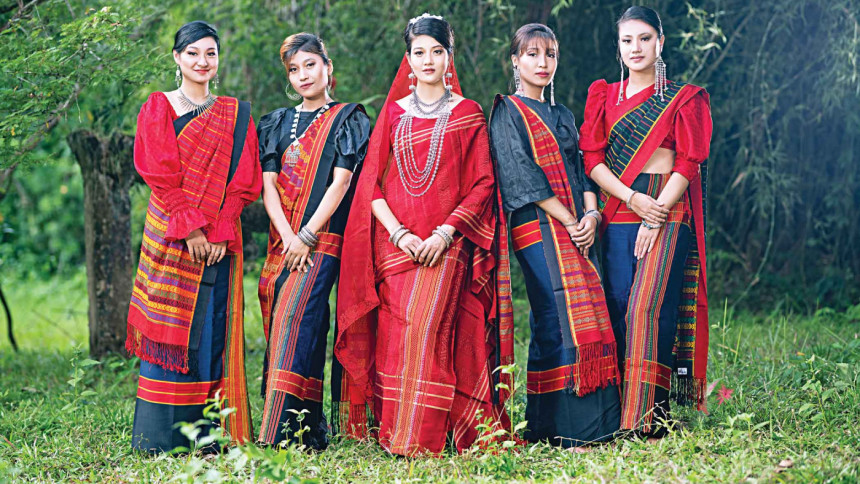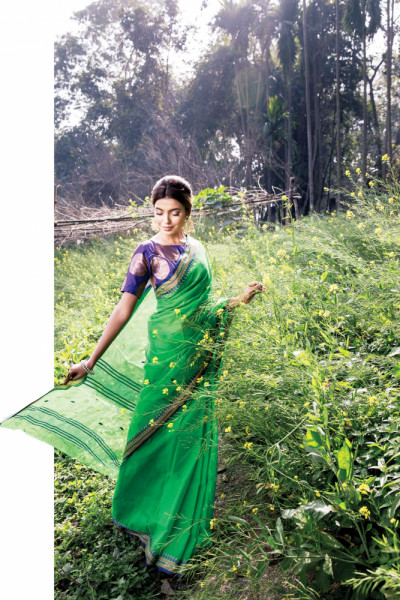Fabrics of Heritage II

Survival story of the Tangail Taant
"Yes, once upon a time, the handloom taant was at its peak. But then came the powerloom variant, parallel to any other sector in the textile industry. That's when we had the hardest time to compete, because powerlooms have the capacity and capability to yield in greater quantity.
"But thankfully with time, people recognised the superiority of the Tangail taant (handloom cotton and silk), which is much more comfortable to wear and more durable. Plus, sari-types like the famous Tantuz could only be handcrafted and produced manually via the handloom and skilled artisans; there are no powerloom alternatives. That's when business peaked again and power looms failed to compete; in fact, they went onto produce a huge amount when the demand fell short, causing many of the powerlooms to shut down," Basak revealed.
The story seemed very uplifting and provided directions to a promising future for the taant industry. When suddenly the pandemic broke out and turned everything including the business topsy-turvy.
"It's very sad that the promising business had to be put to such an abrupt halt. We even had the opportunity to export to our neighbouring countries especially India, since there is a huge demand for the Tangail taant sari over there. But the lockdown and the closure of the borders surely made a mess of the entire trade process," said Basak, to this correspondent.
Inquired, if business would get back on track when the vaccinations took centre-stage and most of the world healed back to its former state, Basak was doubtful.
"I don't think so. How do we sustain for so long, till everything gets normal? We have already lost a year with no celebrations of Baishakh or any of the Eids in 2020.
If we can't get the market in 2021, then most of the tradesmen will be phased out. Because we won't be able to pay the root artisans, who are the most important part of the trade and keep them involved with the manufacturing process. You see, not even a single sari is getting sold in a week, how can we maintain the fees of the artisans, which is set at the minimal rate of Tk 500 per sari?" the tradesman explained.
Upon further discussion, Basak revealed he was yet to get any stimulus package from the BSCIC — Bangladesh Small and Cottage Industries Corporation, or the banks.
"I have been to the banks quite a lot of times; I have taken a natural loan instead, not a part of the stimulus package, by mortgaging my lands to keep the business running. I don't know how much longer I can keep up with this system," Basak revealed.
Discussing the export options, other issues that came to the forefront were the tricks of certain dishonest businessmen.
"We have the opportunity to go big in the export market, as there is great demand for authenticity, handicrafts and heritage fabrics in the world market. However, the problem lies with few dishonest vendors, who are very crucial considering the business viewpoint. The buyers naturally want high quality colours which are well sustained and, in this case, we are tricked by few treacherous suppliers who give us adulterated colours in the name of the real and authentic. There's no process for validation and this only creates a bad image in the international market," said Basak.
While speaking to the experienced tradesman, we also understood that the Tangail silk taant, is also at the beck and call of the silk syndicate, which continuously alters the price to benefit their needs.
"If the price does not increase in the global market, but it 'does' in our local market, naturally our comparative standing would be low. Because our products would be costlier! Our request in such a case would be to establish a proper 'market regulation process' by the topmost authority, so that our industry can survive," added Basak.
A cup of tea with the veteran manufacturer also revealed few other obstacles like how the grass roots artisans were finding alternative job options with a better pay to sustain their livelihoods and did not want to return to their traditional jobs. The lockdown especially forced these people to look for alternative job options, and when they realised that driving an autorickshaw pays almost twice the amount compared to their heritage crafts, they had no other option but to move on.
"This is seriously scary for the trade. Because, the younger generation are unwilling to learn and the middle-aged are leaving the job, that means even if there is an opportunity to grow big in this industry there won't be anyone left to work. So, it is absolutely necessary to train people towards this industry, remove the obstacles that drain out the trade, and make a clearer path to former glory," concluded Basak.

En route the legacies of Pinon-hadi, and the Manipuri handloom
The name Manjulika Chakma is almost synonymous to the pinon–hadi culture in the mystic hills of Rangamati. There perhaps cannot be a more beautiful scenario than the beautiful Chakma girl fetching water from the riverbed in her pinon-hadi, with the majestic hills, set in the backdrop.
Chakma agreed to the notion — "Yes! That was a common scene once," she said, but "times have changed," she added.
The scenario is slightly different, today. The young ladies have moved out of their ancestral homes and travelled far to immerse themselves in the daily duties demanded by an urban lifestyle. No longer do they have the time or opportunity to wear their traditional garb, instead they put on western wear that is easily available and far easier to blend in with.
Chakma slightly disagrees to our assumption.
"Not everyone wears the western cloth or fusion wear or even the Dhakaiite garb. Even today, the ladies of the hill tracts wear the pinon–hadi, especially the homemakers and the elderly. Even the youngsters when they return home, wear the traditional dress so the demand is still there. In fact, it is ever growing because of the increase in the number of populations of the indigenous peoples," reflected Chakma.
Speaking to the recipient of the 2020 Begum Rokeya award, we also learnt that once upon a time the tradition was to make the pinon-hadi by one's own hands. Even the thread was handmade from locally grown cotton plants. Any young lady who could not make the textile on their own, would have to go without the clothing, until and unless someone else took notice and made it for them – which was a rare case. So essentially every girl of the hill tracts knew the weaving process by heart!
"But that is the story of a long time ago. Every girl used to wear one single set of pinon-hadi for an entire year and they would rarely change it until and unless it was beyond repair. Minor tears and scratches were repaired with extra cloth stitched into place. Things have changed so drastically, that today nobody has the time to bother to make the dress on their own. There are special group of people – artisans for this job and my company. 'Bein Foundation' appoints such lady-artisans to craft the special pinon-hadi for everyone," said Chakma.
During our rendezvous, Chakma also revealed that she began with local fabric production, in 1965. It was with lungi, gamcha and thaan kapor first; then we worked on the pinon-hadi — said Chakma. The initiative was taken by her husband and herself after being influenced by Chakma's mother who used to weave the dress by herself like all the other women of the hill tracts.
"To preserve the traditions and bring it to the forefront of the world, I began to work with it. Today, the traditional is anything but lost in the hill tracts; tourists come to our place and procure for themselves as memento and we also have a huge opportunity to export to neighbouring countries, where there is huge demand," mentioned Chakma.
She also revealed that not only were the wardrobe of the women popular amongst the tourist, but also the age-old, authentic traditional bed-sheet, burgi were popular amidst the collectors.
"Burgi might be slightly expensive, considering that it is completely hand-made and unique in design," Chakma said.
The talented designer and entrepreneur feels proud of being able to hold on to the traditions, claiming that she did not feel at all threatened by cheaper power loom copies of the pinon-hadi.
"We should always remain optimistic. Copies will always be there; it only means that the end-product is becoming more popular and people want to wear it. When in reality 'a copy' can never be as good as the original. One who wears the original, will always know the difference.
"A pinon-hadi copy is never comfortable, does not have the authentic Chakma motifs and designs. Those who value the original, especially the black and red combination of pinon-hadi have to come to authentic places, where ladies from the hill tracts make the cloth with their own hands in a komor-taant," Chakma said.
We wanted to know how much an average pinon-hadi could cost. "Somewhere around Tk 5000 to 25000," said Chakma. That's only a trickle considering the massive amount of heritage value and craftsmanship it contains.
From the mystic mountains of the Rangamati belt, we went to the green hills of amazing Sylhet, where Laxmikanta Singh, the executive director of Ethnic Community Development Organisation, Sylhet (ECDO), showed us in broad day light the difference between a fake and an original Manipuri sari. The fake is easily identifiable with harsh quality base fabric, bright contrasting colours that don't easily blend.
"Manipuri sari is an art form just like the Sonargaon Jamdani, the Tangail Tantuz, etc., there can never be a cheaper variant," said Singh, who is himself a member of the Manipuri community.
Singh goes on to add details. "The original Manipuri Sari is crafted by the ladies of the region and consists of a 60-80 thread. It takes almost 20-25 days to make one proper, authentic Manipuri sari with the appropriate, traditional motifs. Whereas the fake 'tetron variant' is made in 2 to 3 days," Singh disclosed.
From a bird's eye view, the competition may seem to be high when in reality to the trades people, like Singh, this competition is insignificant because fakes are losing their charm and people are becoming aware of the difference.
"The fake is nowhere close! The only shortcoming that we have today is the lack of craftspeople. This trade is specifically done by the women, without them it is impossible to craft the exquisite Manipuri, but the ladies today are moving away from the traditional craftsmanship ideologies and getting involved in other jobs," Singh said.
What we learned from our conversation with the expert was that there was huge opportunity in both the local and export field, for the Manipuri handloom. But supply was short due to the shortage in fine-skilled artisans. But Singh was not too sceptical about the future.
He already had structured plans to be set in motion once the pandemic was over, to train more ladies of the region in the craft. So, that the majestic Manipuri, is able to reach its 'truly deserved status' in the world of handloom.
Pinon Hadi Wardrobe: Sazpodor By Tenzing Chakma


 For all latest news, follow The Daily Star's Google News channel.
For all latest news, follow The Daily Star's Google News channel. 



Comments